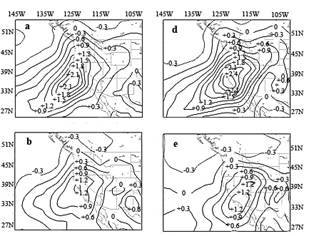
|
Ensemble guidance (continued) |
|
Using climatological anomalies as a forecast tool |
|
Hart and Grumm (2001) have used standardized anomalies to rank synoptic scale events from a climatology developed from the NCEP reanalysis. The standardized anomalies essentially scale the anomaly by the its standard deviation from the mean. The beauty of using standardized anomalies (SDs) is that the standard deviation provides information about the frequency of occurrence of whatever forecast parameter than you are looking at. As noted by Grumm and Hart (2001), a departure from normal of 2.5 SDs implies that the observed value occurs between 5% and 16% of the time. For fields like 500-hPa or 700-hPa heights the actually confidence limit is probably close to that of a normal distribution. Neither precipitable water (PW) nor the magnitude of 850-hPa magnitude of the moisture flux (MF)have a normal distribution, but even they appear to have confidence limits near that of a normal distribution. Note how over 99 percent of the time, the PW and 850-hPa magnitude of moisture flux is below 3 SDs. |
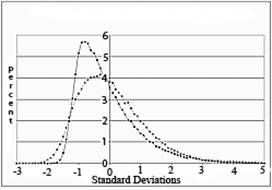
|
Magnitude of moisture flux |
|
Precipitable water |
|
Histogram showing the percentage of the distribution of PW and 850-hPa magnitude of moisture flux. |
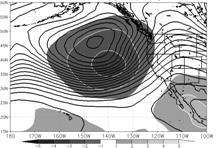
|
700-hPa geopotential height and standardized anomaly of the height field (shaded) valid 0000 UTC 9 Jan 1995. |
|
-3 SD |
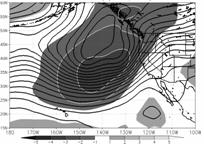
|
700-hPa geopotential height and standardized anomaly of the height field (shaded) valid 1200 UTC 9 Mar 1995. |
|
-3 SD |
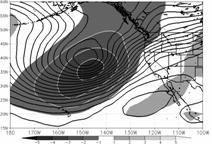
|
-3 SD |
|
700-hPa geopotential height and standardized anomaly of the height field (shaded) valid 1200 UTC 31 Dec 1997. |
|
The 700-hPa height and standardized anomaly pattern for three different multi-day extreme rainfall events are shown below. Note that each has a greater than 3 SD height anomaly off California associated with it. The greater than 3 SD departure from normal suggests that 99% of the time during this time of year, the 700-hPa geopotential height anomaly is less than the observed anomalies during these three events. |
|
Heavy west coast precipitation events during winter usually are associated with a fairly strong negative anomaly with a weaker positive height anomaly to the southeast. All three of these multiday extreme rainfall events were associated with such a pattern which pretty much assures a strong southwesterly geopotential height gradient. Lackmann and Gyakum (1999) found a similar pattern of 500-hPa height anomalies with a similar couplet associated with heavy cold season precipitation events in the northwestern U.S. They noted that during their cases, this anomaly pattern often resulted in warm, moist air from near the Hawaiian Islands being transported northeastward into Washington and Oregon. Bell and Pereira (2005) found a similar 500-hPa and 700-hPa anomaly pattern associated with heavy rainfall events over the mountains of southern California. These various research efforts establish that the 500-hPa, 700-hPa geopotential height and anomaly patterns are very similar for all heavy precipitation events along the west coast with the primary differences are the north-south displacement of the anomalies
|
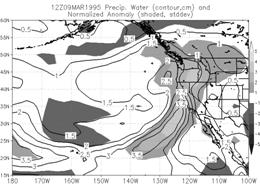
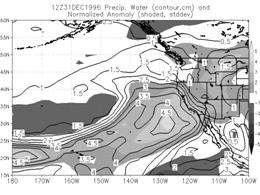
|
1200 UTC 9 Mar 1995 PW (contour) and Normalized PW anomaly (shaded, unit=1 SD. |
|
There were other indications that these three northern California events would be major rainfall events. The deep southwesterly flow associated with the pattern tapped into moisture in the subtropics which led to the anomalously high PW values being pulled northeastward. Two of the three events was associated with greater than 3 SD anomalies and the third with a 2.5 SD (not shown). |
|
1200 UTC 31 Dec 1997 PW (contour) and Normalized PW anomaly (shaded, unit=1 SD. |
|
3 SD |
|
4 SD |
|
All three events were associated with plumes of moisture that impinged upon the coast. The role of these plumes or atmospheric rivers is even more evident when anomalies of the magnitude of 850-hPa moisture flux is examined. Let’s first look at the moisture flux anomalies associated with the January and March 1995 events (see below). The shaded areas are anomalously high MF anomalies with the white area having a 5 SD departure from normal. |
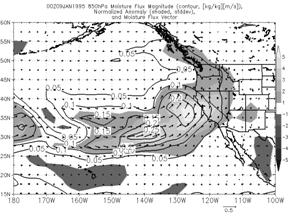
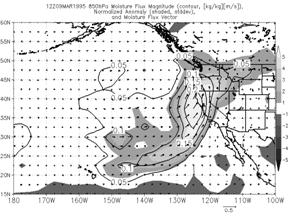
|
850-hPa moisture flux (arrows) and magnitude of the moisture flux (solid) and anomaly of the magnitude of the moisture flux (shaded, unit= 1SD) valid 0000 UTC 9 Jan 1995. |
|
5 SD |
|
5 SD |
|
850-hPa moisture flux (arrows) and magnitude of the moisture flux (solid) and anomaly of the magnitude of the moisture flux (shaded, unit= 1SD) valid 1200 UTC 9 Mar 1995. |
|
The 5 SD moisture flux anomaly impinging upon the coast suggests that the both 1995 rainfall events might be relatively rare as more than 99.999% of the time the moisture flux will be lower than on the two maps above. Significant flooding and flash flooding also occurred over the Sacramento, Napa, and Sonoma Valleys as a result of rainfall during the eight-day period, January 7-15, 1995 (NOAA 1995), prompting thirty-four counties to be declared federal disaster areas. The March 9-10, 1995 caused considerable flooding on the San Joaquin basin (Reynolds 1996). The combined damage from the January and March 1995 floods exceeded 305 million dollars in the Sacramento Valley and 193 million in the San Joaquin Valley (Army Corps of Engineers 1999).
Let’s explore the 850-hPa moisture flux and MF anomalies during the period from 0000 31 Dec. 1996 through 0000 UTC 2 Jan. 1997 and explore the relationship of the maximum rainfall to the axis of strongest 850-hPa MF. During the entire period, the standardized MF anomalies were at least 4 SD and usually 5 SD. Again the normalized anomaly pattern signalized that there was the potential for a relatively rare, extreme rare precipitation event over California. This particular event, caused nearly two billion dollars in property damage and forced over 100,000 people from their homes (Baird and Robles 1997). |
|
From Junker et al. 2007 |
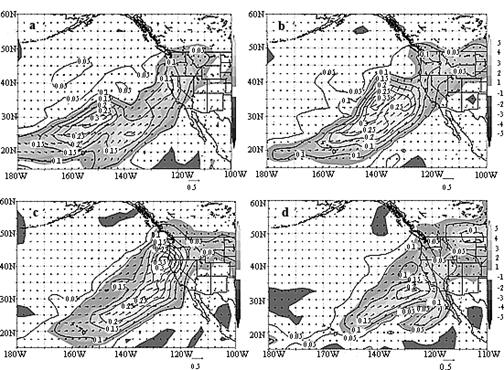
|
850-hPa moisture flux (arrow, scale shown at bottom of image), magnitude of moisture flux (interval=0.05 ms-1) and normalized anomaly of moisture flux (magnitude of the anomaly is shaded with the scale on the right hand side of the figure, interval=1 SD) for a) 0000 UTC 31 Dec. 1996, b) 1200 UTC 31 Dec. 1996, c) 0000 UTC 1 Jan. 1997, and d) 0000 UTC 2 Jan. 1997. |
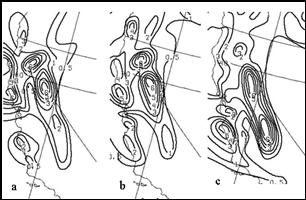
|
During upslope events, the anomalously moisture flux impinging upon the coast and mountains helps determine the location of where the heaviest rainfall will occur. The axis of strongest moisture flux was located north of San Francisco during the 24 hour periods ending at 1200 UTC 31 Dec. 1996 and 1200 UTC 01 Jan. 1997. By 0000 UTC 2 Jan. 1997 the axis had shifted south of San Francisco, only then did very heaviest rainfall shift south of the city (see figures below). |
|
24 hr HPC precipitation analysis for, a) 1200 UTC 31 Dec 1996, b) 1200 UTC 1 Jan 1997, and c) 1200 UTC 2 Jan 1997. |
|
All three of these multi-day rainfall events was associated with a “pineapple express” or atmospheric river where there was anomalously high PW and MF. Ralph et al. (2006) seven floods on the Russian River that were associated with landfalling atmospheric rivers attesting to their importance in producing excessive rainfall. |
|
Standardized 850-hPa moisture flux (arrow) and magnitude of moisture flux field at the beginning of the period of heavy rainfall, a) for 4 inch or greater events and b) for 2-4 inch events; at the end of the period, c) for 4 inch or greater events, and d) for 2-4 inch events. |
|
There are differences in the moisture flux and PW anomaly fields between events that produce heavy rainfall compared to those that produce more modest amounts (see above). The differences in the anomaly fields for moderate and heavy support the idea that anomalies can be used to identify major rainfall events. The similarity of the 500-hPa, 700-hPa and 850-hPa moisture flux patterns at locations from the Pacific Northwest (Lackmann and Gyakum) and southern California (Bell and Pereira 2005) to the anomaly patterns shown above for northern California suggest that standardized anomalies may also be a useful forecast tool along the entire west coast. |